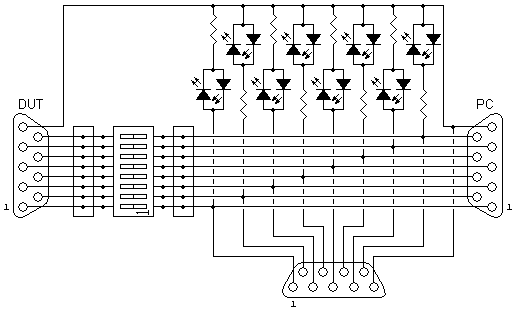|
Such a device is particularly useful in solving interfacing problems. This following is a device which is inserted between the DTE and DCE. Firstly, it allows you to monitor the state of the various hand-shaking lines (light red = signal ON, green = OFF), and watch the serial data flicker on TD and/or RD. Secondly, it allows you to break the connection on one or more of the lines (with dip-switches), and make any kind of cross-connections and/or wraparounds (with jumper wires). Using this, it is fairly easy to determine which line(s) are not functioning as required, and quickly build a prototype of cable that will serve to interface the two devices. At this point, the break-out box can be removed and a real cable built that performs the same function.
There is an unusual feature to this break out box not seen on any commercial designs to date - the inclusion of a "sniffer port". The advantage of this connection is a means to connect in an RS232 monitoring device (such as seen here) without having to break the connection while doing so. Resistors are standard 3.3kΩ, and LEDs are 2-wire dual colour (please be careful, there are dual colour 3-wire types and they will not work). They are wired in to match your way of thinking. I prefer RED when the signal is positive, and GREEN when negative. However, some prefer green=go and red=stop. Your choice. Care should be taken with this type of device to connect the correct end of it to the DTE device, or the lights and switches do not correspond to the actual signals.
© 27.08.03 |
